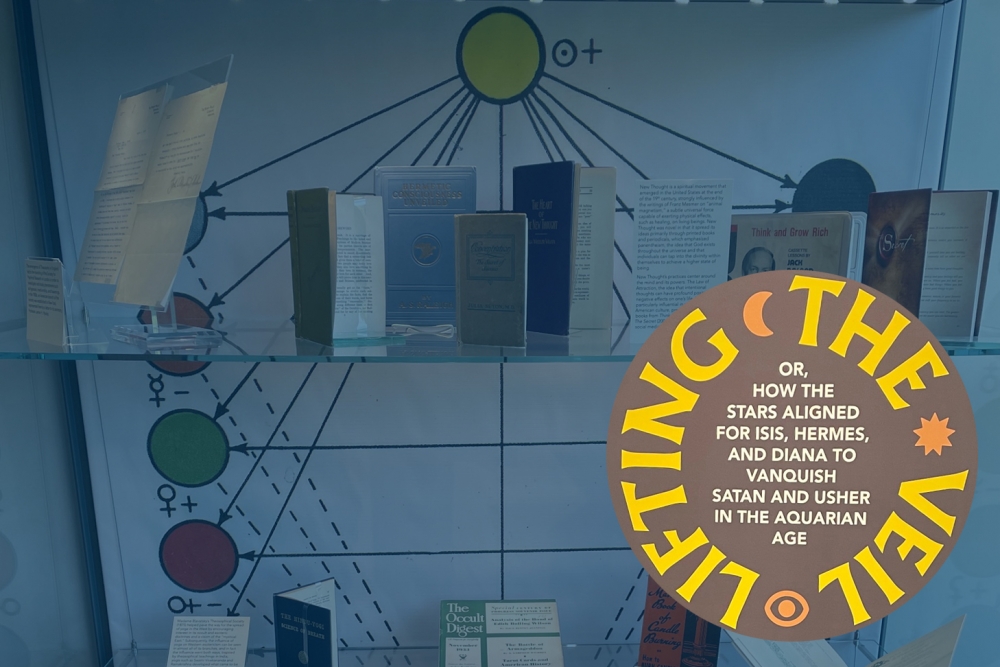
The Old Roots of New Age

Here’s the thing about the “New Age” movement: Most of it isn’t “new” at all.
Notions such as summoning the gods or goddesses within, the power of positive thinking and finding female empowerment through witchcraft can be traced back to the late 19th century.
A new exhibit at the UC Santa Barbara Library lays out how these once-obscure beliefs spread through publishing and pop culture. “Lifting the Veil, or, How the Stars Aligned for Isis, Hermes, and Diana to Vanquish Satan and Usher in the Aquarian Age,” includes books, manuscripts, LPs, cassettes and even board games, all of which document how these ideas — some of them ancient, others newly minted — circulated widely beginning in the 1890s.
“Ideas that people may have learned for the first time through Oprah are, in fact, over 100 years old,” said Special Research Collections Librarian David Gartrell, who curated the exhibit. “‘The Secret,’ which describes the ‘law of attraction,’ was a big best seller, but the same ideas can be found in a number of ‘New Thought’ publications we have from the first decade of the 20th century.”
“Lifting the Veil” is on display for the entire academic year, through June 30, 2023. An opening reception will take place Tuesday, Oct. 11 in the library’s Special Research Collections (3rd Floor, Mountain Side).
“I wanted to explore the publishing trends in Western esoteric currents, and how they went from serving a specific audience to having a much broader influence on American culture by the end of the 20th century,” said Gartrell, who has been curator of the American religions collection for the past 20 years. “That was my concept.”
The exhibit includes “books, manuscripts, correspondence course lessons, which were an important way of spreading ideas in the 20th century,” he noted. “We have LPs, cassettes, journals. There is a listening station; all the audio in the exhibit is available for visitors to listen to.”
That includes an audio version of Napoleon Hill’s 1937 best-seller “Think and Grow Rich” (still for sale on Amazon), which preached the power of positive thinking nearly 70 years before “The Secret.”
“There are lighter elements to it as well,” Gartrell added. “There’s a palmistry board game from the early ‘70s, and a ‘How to Cast Your Own Black Magic Spell’ board game.”
“Many of these ideas had been around in the Renaissance, but they ebbed to the point they were either forgotten or mocked during the Age of Enlightenment,” Gartrell noted. “They reemerged in the 19th century, as people started to apply rationalism and what they thought of as scientific reasoning to them.”
As early as 1885, these ideas were being circulated by Helena Blavatsky, “an aristocratic world traveler” and founder of the Theosophic Society. Blavatsky claimed she was passing along wisdom she obtained from Tibetan gurus. “I don’t know if anyone believed her, even at the time,” Gartrell said, “but she told a good story.” And good stories get passed around.
“At first, these ideas were largely confined to initiatory groups, where masters would hand down knowledge to their pupils,” Gartrell noted. But as the exhibit shows, over time they begin to spread widely through many forms of communication, evolving constantly as one offshoot beget another. Gradually, their emphasis shifts from group rituals to the all-American theme of individual self-empowerment.
One particularly fascinating aspect of this history is the way witches and witchcraft began to take on a more positive connotation than they had historically — at least for some. Gartrell traces this back to the 1889 book “Aradia, or the Gospel of the Witches” by Charles Leland.
“Leland was an American who spent a lot of time in Florence,” he said. “He said he befriended a fortune teller there, who told him about this pre-Christian witch tradition she was a part of, which worshipped Diana, the goddess of the moon. This was radically different from past portrayals of the Devil, and Leland either exposed or invented it. We do not know. Either way, his book was the beginning of Wicca.”
Perusing the exhibit, two themes become clear. First, these esoteric spiritual movements emerge in reaction to societal shifts, such as the desire to synthesize science and religious faith, and the women’s rights movement. Second, many people find the idea of knowing and sharing purportedly secret or hidden information extremely enticing — especially when it is said to reflect ancient wisdom.
“The manuscripts, photographs, correspondence and more in the library’s American Religions Collection tell a fascinating story about 20th century nontraditional religions in North America, yet this is the first time the library has exhibited items from this collection,” said events and exhibitions librarian Alex Regan. “I hope visitors to the exhibition will be motivated to learn more about these rich archival research materials.”
Gartrell shares that goal, along with one other: “I also hope people appreciate that some of these ideas have been around longer than you might think.”



